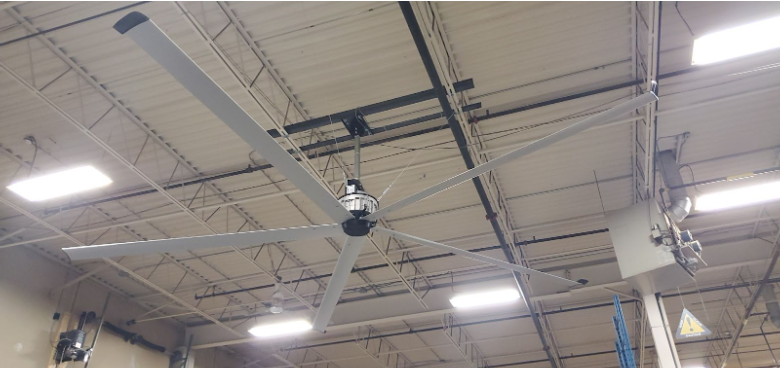
Not all fans are the same. While most of us are familiar with the common fans we install in our living rooms or bedrooms, HVLS fans belong to an entirely different class designed for much larger spaces.
What is an HVLS fan?
The acronym for High-Volume Low-Speed is HVLS. These huge fans deliver large volumes of air at relatively low rotational speeds and are often over seven feet in diameter. They are commonly installed in barns, factories, and warehouses, as well as in other business, trade, and farming buildings. The primary purpose of an HVLS fan is generally to adequately distribute air throughout a large area with the aim of creating more comfort.
The Primary Components of HVLS Fans
- Size and Reach: Compared to residential fans, HVLS fans are noticeably larger. They are able to circulate air over enormous areas because their large blades can reach up to 24 feet in diameter.
- Air Movement: By moving a lot of air at slow speeds, these fans produce a soft, pervasive breeze that effectively cools enormous areas.
- Energy Efficiency: HVLS fans are very energy efficient despite their size. They consume less energy than several smaller fans that would be required to cover the same area.
- Silent Operation: HVLS fans also have the advantage of not making much noise, making them suitable for areas that need minimal noise interference.
- Flexibility: Because of the sturdiness of the panels and the ability to adapt to different functions, they can be used in gyms, barns, and warehouses and even for very large commercial buildings.
What is a Residential Fan?
Residential fans are the regular fans seen in homes, as opposed to other types. Some of the sizes and styles include box fans, pedestal fans, and ceiling fans. Residential fans are useful for bedrooms, living rooms, kitchens, and patios because they are designed to cool enclosed areas.
Essential Components of Residential Fans
- Dimensions and Portability: These fans are more compact and lightweight. They are easily transportable from one place to another, and their sizes typically range from a few inches for tiny desk fans to several feet for ceiling fans.
- Speed and Airflow: These fans provide a more concentrated airflow that may swiftly cool a particular region since they run faster than HVLS fans.
- Design and Appeal: Residential fans are available in a range of designs and styles that complement any type of interior décor. They may offer style and sophistication to any space.
- Accessibility: Most homes can obtain them because they are reasonably priced and easily accessible.
- Installation Ease: Installing and maintaining residential fans is not that difficult. Pedestal and box fans can be used immediately, whereas ceiling fans may need some electrical work done.
Comparing HVLS Fans and Residential Fans
- Purpose and Use Case
HVLS Fans: Suitable for commercial, industrial, and agricultural settings, HVLS fans are built for broad areas. Large retail establishments, manufacturing buildings, warehouses, and agricultural facilities all employ them to increase air circulation. They contribute to temperature regulation, humidity reduction, and improved air quality overall by circulating enormous quantities of air.
Residential Fans: These fans are designed for modest, personal environments. When focused cooling is required, they are ideal for use in homes, workplaces, and small commercial spaces. In kitchens, living rooms, bedrooms, and patios, residential fans quickly remove heat buildup.
- Airflow and Temperature Regulation
HVLS Fans: HVLS fans are efficient in moving large volumes of air within a relatively short amount of time. This creates a gentle breeze that can blow over a large area, making them very effective in cooling the area and cleaning the air in large regions. By dispersing conditioned air more uniformly, the soft airflow lessens hot and cold patches.
Residential Fans: The airflow produced by these fans is more focused and direct since they operate at faster speeds. This is the best way to rapidly cool smaller regions. They might, however, be less successful in large spaces where proper air circulation is essential.
- Energy Efficiency
HVLS Fans: The energy efficiency of HVLS fans is one of their main benefits. They use less energy than several smaller fans because they move enormous quantities of air at low speeds. Particularly in big commercial and industrial environments, this can lead to significant energy savings.
Residential Fans: While residential fans are likewise energy-efficient, their effectiveness is limited to smaller areas. Energy usage may increase if more residential fans are used to cover a larger area.
- Expense and Installation
HVLS Fans: Because of their size and the technology they use, these fans require a larger initial investment. Installation might be more difficult, typically necessitating professional assistance. Still, the initial expenditure may be compensated for by long-term energy savings and better air quality.
Residential Fans: Most homes can afford and easily install residential fans because they are more accessible. It’s simple to locate one that suits your budget because they come in a range of price points.
Conclusion
Although the main functions of HVLS and residential fans are cooling and air circulation, there are notable differences in their applications, efficiency, and impact. Understanding the key differences between these types of fans will allow you to make an informed decision based on your individual requirements.
Modern HVLS fan systems from Refresh Fans outperform conventional residential fans. They are designed with energy efficiency, modern technology, and configurable features to provide strong airflow in commercial, industrial, and agricultural environments. Get in touch with us to learn more.